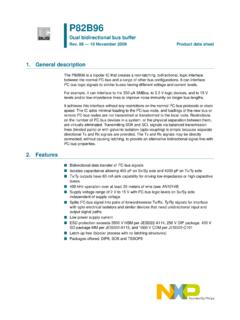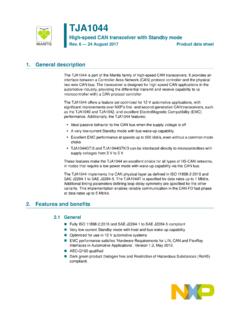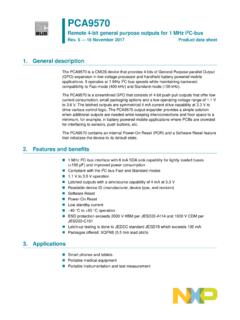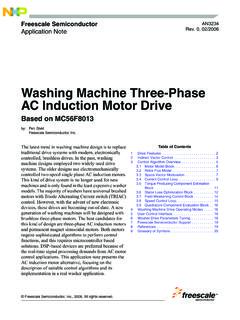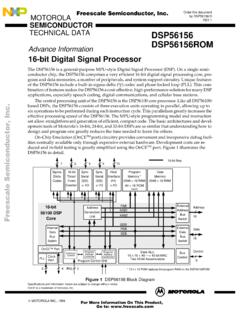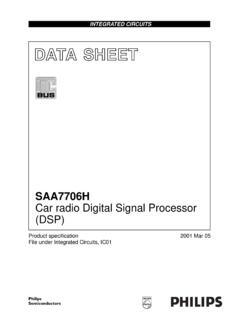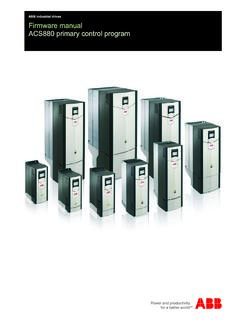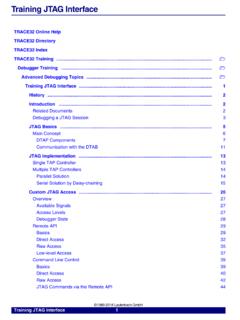Transcription of Hardware and Layout Design Considerations for DDR …
1 Freescale SemiconductorApplication Note Freescale Semiconductor, Inc., 2003, 2007. All rights reserved. Embedded systems that use double data rate memory (DDR) can realize increased performance over traditional single data rate (SDR) memories. As the name implies, DDR enables two data transactions to occur within a single clock cycle without doubling the applied clock or without to doubling the size of the data bus. This increased data bus performance is due to source-synchronous data strobes that permit data to be captured on both the falling and rising edges of the DDR can bring improved performance to an embedded Design , care must be observed in the schematic and Layout phases to ensure that desired performance is realized. Smaller setup and hold times, cleaner reference voltages, tighter trace matching, new I/O (SSTL-2) signaling, and the need for proper termination can present the board designer with a new set of challenges that were not present for SDR designs.
2 Document Number: AN2582 Rev. 6, 04/2007 Contents1 SSTL-2 and Termination ..22 DDR Signal Groupings ..43 Controller Signal Pinout ..54 Board Stack-Up ..55 Layout Order for the DDR Signal Groups ..66 Length Matching Overview ..67 Layout Guidelines for the Signal Groups ..78 Layout Guidelines for Specific Implementations ..229 logic analyzer Support Packages ..2810 Interface Timing Analysis and Other Considerations 2811 Improving Eye Diagrams ..4112 Simulation ..4213 DDR Designer Checklist ..4314 Useful References ..4615 Revision History ..46 Hardware and Layout Design Considerations for DDR Memory InterfacesbyDSD ApplicationsFreescale Semiconductor, , TXHardware and Layout Design Considerations for DDR Memory Interfaces, Rev. 62 Freescale Semiconductor SSTL-2 and TerminationDesign challenges confronting the board designer can be summarized as follows: Routing requirements Power supply and decoupling, which includes the DDR devices and controller, the termination rail generation (VTT), and reference generation (VREF) Proper termination for a given memory topologyThis application note provides several Layout Considerations within these areas and includes recommendations that can serve as an initial baseline for board designers as they begin specific implementation, which can consist of the following.
3 Single or multi-DIMM registered, unbuffered Single or multi SO-DIMM registered, unbuffered Soldered-down discrete implementation Mixture discretes plus DIMM expansion slotsBesides memory, composite memory topologies can also include on-board logic analyzer connections and expansion DIMM cards with analyzer Design guidelines in this document apply to PowerQUICC products that leverage the DDR IP core and are based on a compilation of internal platforms designed by Freescale. These guidelines minimize board-related issues across multiple memory topologies while allowing maximum flexibility for the board designer. Because numerous memory topologies and interface frequencies are possible on the DDR interface, Freescale highly recommends that the board designer verify, through simulation, all aspects (signal integrity, electrical timings, and so on) before PCB fabrication.
4 Also, be sure to consult the latest errata. Any AC timing parameters within this document are for reference purposes only. The designer should consult the official AC specifications for a given and TerminationFor DDR-I memories, JEDEC created and adopted a low voltage, high-speed signaling standard called series stub termination logic (SSTL). SSTL leverages an active motherboard termination scheme and overcomes the signal integrity concerns with legacy LVTTL signaling. As the name implies, SSTL is suited for use in mainstream memory interfaces where stubs and connectors are present. The V version, named SSTL-2, is prominent with DDR1 memories and is defined within JESD8-9B. The memory controller s drivers and receivers are most common SSTL termination is the class II single and parallel termination scheme shown in Figure 1.
5 This scheme involves using one series resistor (RS) from the controller to the memory and one termination resistor (RT) attached to the termination rail (VTT). This approach is used in commodity PC motherboard designs. Values for RS and RT are system-dependent and should be derived by board simulation. See Section 12, Simulation, for a list of potential termination ranges. Use of the mainstream termination in commodity PC motherboards is assumed in this document. Consequently, differing termination techniques can be valid and useful, but the designer should use simulation to validate this a typical memory topology, the series damping resistor (RS), if used, is placed away from the controller. This approach has two distinct advantages. It frees precious board space around the memory controller, Hardware and Layout Design Considerations for DDR Memory Interfaces, Rev.
6 6 Freescale Semiconductor3 SSTL-2 and Terminationavoiding Layout congestion and burdensome fanout. Also, it optimizes the signal integrity for the signals sent from the controller to the memories, where more signals (addr + cmd) must be reliably received by multiple devices. Figure 1. Typical Memory Interface Using Class II OptionTo realize the increased signaling frequencies, SSTL leverages high-gain differential receivers that are biased around a reference voltage denoted as VREF. Using these receivers allows a smaller voltage swing, reducing signal reflections, lowering EMI, improving settling time, and yielding higher possible clock rates than with LVTTL signaling. Figure 2 shows the SSTL interface levels. The AC logic levels are the points at the receiver where the AC input timing parameters (setup and hold) must be satisfied.
7 The DC logic levels provide a point of hysteresis. When the input level crosses the DC reference point, the receiver switches to the new logic level and maintains this new state as long as the signal does not cross below the threshold. Consequently, SSTL buses are less susceptible to overshoot, undershoot, and ringing 2. SSTL SignalingDriverReceiverRTRSVTTVREFVINVIN VDDQ ( V Minimum)VOH(MIN) VVOL(MAX)VSSQVIHACVREF + AC NoiseVREF + DC ErrorVREF DC ErrorVREF AC NoiseVIHDCVILACVILDCNote that numbers are nominal, utilizingRS = RT = 25 .TransmitterReceiverHardware and Layout Design Considerations for DDR Memory Interfaces, Rev. 64 Freescale Semiconductor DDR Signal DissipationSink and source currents flow through RS and RT. Assuming worst-case parameters and that the Class II termination scheme of Figure 1 is used, the power dissipation for these resistors is as follows:P(RT and RS) = I2 * R = ( mA)2 * (25 ) = mW.
8 NOTESee Section , DDR VTT Voltage Rail, for current compact 4-pin resistor packages (16 mm 32 mm) that provide dissipation up to 1/16 watt ( mW) are available. Such devices are ideal for the DDR Signal GroupingsThe DDR memory controller consists of more than 130 signals and provides a glueless interface for the memory subsystem. These signals can be divided into the following signal groups for the purpose of this Design guide: Clocks Data Address/Command Control Feedback signalsTable 1 depicts signal groupings for the DDR interface. The remaining sections of this document give PCB Layout recommendations for each 1. DDR Signal Groupings for Routing PurposesGroupSignal NameDescriptionSectionClocksMCK[0:5]DDR differential clock outputs See Section , Clock Signal Group MCK[0:5] and MCK[0:5] MCK[0:5]DDR differential clock outputs (complement)DataMDQ[0:63]64-bit data busSee Section , Data MDQ[0:63], MDQS[0:8], MDM[0:8], MECC[0:7] MECC[0:7]ECC pinsMDM[0:8]Data mask pinsMDQS[0:8]Data strobe pinsAddress/CommandMA[0:14]Address busSee Section , Address and Command Signal Group MBA[0:1]Bank addressMRASRow address strobeMCASC olumn address strobeMWEW rite enableHardware and Layout Design Considerations for DDR Memory Interfaces, Rev.
9 6 Freescale Semiconductor5 Controller Signal Pinout3 Controller Signal Pinout The pinout for the DDR interface facilitates ease of routing to a standard JEDEC DIMM connector. For non-DIMM topologies (that is, discretes), DDR devices should be similarly placed to optimize signal fanout. Figure 3 shows general DDR controller pinout flow. The figure shows generic topology if a series damping (RS) and parallel termination (RT) scheme is 3. General DDR Controller Pinout Flow4 Board Stack-UpFreescale recommends placing all DDR signals on critical layers that are ground-referenced, which ensures the lowest impedance for the return currents and provides improved signal integrity performance. Ground referencing is especially critical for the data group as it operates at the 2x clock rate.
10 If trade-offs must be made, allow the data and clock signal groups to be routed over solid ground planes and other DDR signal groups to be routed over solid power [0:1]Clock enableSee Section , Control Signal Group MCS[0:3]Chip selectsFeedbackMSYNC_OUTDRAM DLL synchronization outputSee Section , Feedback Signal Group MSYNC_INDRAM DLL synchronization inputPowerVREFV oltage reference for differential receiversSee Section , DDR Power Delivery VTTT ermination voltageTable 1. DDR Signal Groupings for Routing Purposes (continued)GroupSignal NameDescriptionSectionDDRP owerQUICCDIMM0 DIMM1 VTT IslandSegment ASegment BSegment CRegionHardware and Layout Design Considerations for DDR Memory Interfaces, Rev. 66 Freescale Semiconductor Layout Order for the DDR Signal GroupsEach ground or power reference must be solid and continuous from the BGA ball through the end termination.

